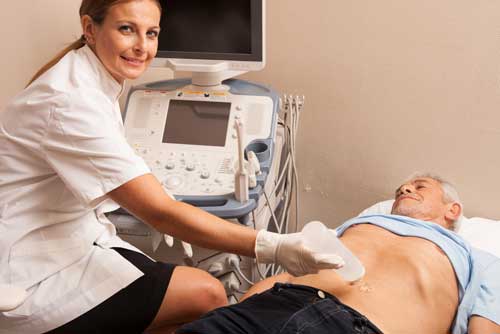Abdominal Aortic Aneurysm (AAA)
Abdominal aortic aneurysm (AAA) occurs when atherosclerosis or plaque buildup causes the walls of the abdominal aorta to become weak and bulge outward like a balloon. An AAA develops slowly over time and has few noticeable symptoms. The larger an aneurysm grows, the more likely it will burst or rupture, causing intense abdominal or back pain, dizziness, nausea or shortness of breath.
Your doctor can confirm the presence of an AAA with an abdominal ultrasound, abdominal and pelvic CT or angiography. Treatment depends on the aneurysm's location and size as well as your age, kidney function and other conditions. Aneurysms smaller than five centimeters in diameter are typically monitored with ultrasound or CT scans every six to 12 months. Larger aneurysms or those that are quickly growing or leaking may require open or endovascular surgery.
What is an abdominal aortic aneurysm?
The aorta, the largest artery in the body, is a blood vessel that carries oxygenated blood away from the heart. It originates just after the aortic valve connected to the left side of the heart and extends through the entire chest and abdomen. The portion of the aorta that lies deep inside the abdomen, right in front of the spine, is called the abdominal aorta.
Over time, artery walls may become weak and widen. An analogy would be what can happen to an aging garden hose. The pressure of blood pumping through the aorta may then cause this weak area to bulge outward, like a balloon (called an aneurysm). An abdominal aortic aneurysm (AAA, or "triple A") occurs when this type of vessel weakening happens in the portion of the aorta that runs through the abdomen.
The majority of AAAs are the result of atherosclerosis, a chronic degenerative disease of the artery wall, in which fat, cholesterol, and other substances build up in the walls of arteries and form soft or hard deposits called plaques.
Abdominal aortic aneurysms typically develop slowly over a period of many years and hardly ever cause any noticeable symptoms. Occasionally, especially in thin patients, a pulsating sensation in the abdomen may be felt. The larger an aneurysm grows, the greater the chance it will burst, or rupture.
If an aneurysm expands rapidly, tears, or leaks, the following symptoms may develop suddenly:
- intense and persistent abdominal or back pain that may radiate to the buttocks and legs
- sweating and clamminess
- dizziness
- nausea and vomiting
- rapid heart rate
- shortness of breath
- low blood pressure.
Major risk factors for an AAA include family history, smoking and longstanding high blood pressure. According to the Centers for Disease Control and Prevention (CDC), men who have a history of smoking should receive a one-time screening for triple A between the ages of 65 and 75. Men with a family history of AAA should be screened at age 60.
How is an abdominal aortic aneurysm diagnosed and evaluated?
Many abdominal aortic aneurysms are incidentally found on ultrasound examinations, x-rays or CT scans. The patient is often being examined for an unrelated reason. In other patients who experience symptoms and seek medical attention, a physician may be able to feel a pulsating aorta or hear abnormal sounds in the abdomen with the stethoscope.
To confirm the presence of an abdominal aortic aneurysm, a physician may order imaging tests including:
- Abdominal Ultrasound (US): Ultrasound is a highly accurate way to measure the size of an aneurysm. A physician may also use a special technique called Doppler ultrasound to examine blood flow through the aorta. Occasionally the aorta may not be completely seen due to overlying bowel which blocks the view of ultrasound or in very large patients.
- Abdominal and pelvic computed tomography (CT): This exam is highly accurate in determining the size and extent of an aneurysm. See the Safety page for more information about CT.
- Angiography: This exam, which uses x-rays, CT or MRI and a contrast material to produce pictures of major blood vessels throughout the body, is used to help identify abnormalities such as abdominal aortic aneurysms.
How is an abdominal aortic aneurysm treated?
Treatment depends on a variety of factors, including size and location of the aneurysm within the abdominal aorta and the patient's age, kidney function and other conditions.
Patients with aneurysms that are smaller than five centimeters in diameter are typically monitored with ultrasound or CT scans every six to 12 months and may be advised to:
- quit smoking
- control high blood pressure
- lower cholesterol.
Surgical treatment may be recommended for patients who have aneurysms that are:
- larger than 5 centimeters (two inches) in diameter
- quickly growing
- leaking.
There are two treatment options:
- Traditional (open) surgical repair: In this type of surgery, an incision is made in the abdomen and the damaged part of the aorta is removed and replaced with a synthetic tube called a stent graft, which is sewn into place.
- Endovascular surgery: In this procedure, which is less invasive than an open repair, the stent graft is attached to the end of a thin plastic tube called a catheter, inserted through an artery in the leg and maneuvered up into the abdomen, where it is positioned inside the aneurysm and fastened in place with small hooks.
Which test, procedure or treatment is best for me?
This page was reviewed on April 16, 2022



